Columnist Judith Torres With Vianca Añonuevo Favila
Images Trieu Chien and Hiroyuki Oki




Project Rating:
Judith Torres: ![]()
![]()
![]()
Vianca Añonuevo Favila: ![]()
![]()
![]()
“Honestly, I have never seen a house like this before,” says Vianca Añonuevo Favila, one of the design principals of Empire Designs, a Manila-based interior design firm.
“The reason I gravitated towards critiquing this house was precisely its unique design. And the first thing that popped in my head was user-experience and maintenance. Those two things, apart from budget, are always top priority when we design, so I wanted to know the thought process behind this beautiful home. What is the owner like? What are their day-to-day activities?”
We both loved the photos on the website, but they raised so many questions, which we couldn’t figure out because there were no floor plans.
To prepare for our teleconference interview with Nguyen Hoang Manh, Favila and I scoured MIA Design Studio’s website to get a sense of his values and design philosophy, and choose two to three projects to discuss with him. I didn’t want to review architecture without visiting the site and talking to the homeowners (you always gain insights when you find out which spaces are least used and where people enjoy congregating and spending time alone). So, I was leaning towards a condominium penthouse unit. At least this way, we couldn’t fault Nguyen for the architecture because he had to work within a shell and parameters someone else designed.
Favila, however, really wanted to talk to Nguyen about the Sky House. I was attracted to it too. I’d seen a raw, brutalist, and smaller version in Kuala Lumpur by Formzero and was curious to see how far their similarities went.
We were also intrigued by the owner. What were his or her values? What brief did he or she give MIA Design Studio that led to the unorthodox and poetic responses in the architecture? Here is MIA Design Studio’s description of the house:
“In combination with our desire is the personality of the owner who loves and enjoys inner peace and calmness. Therefore, the design team was determined to have a clear idea for the architectural plan, which could promote a deep horizontal and vertical connection between human to human and human to nature in this house.”
The deep horizontal and vertical connections could be speaking of the equality of men while recognizing the authority and wisdom of one over the other, as in a family. Then the horizontal and vertical relationship of man with nature might be about man recognizing he is part of nature while appreciating its power and primacy. What an awesome philosophy to inspire architecture. If we couldn’t talk to the owner, we would ask Manh how the client conveyed and stirred these thoughts.
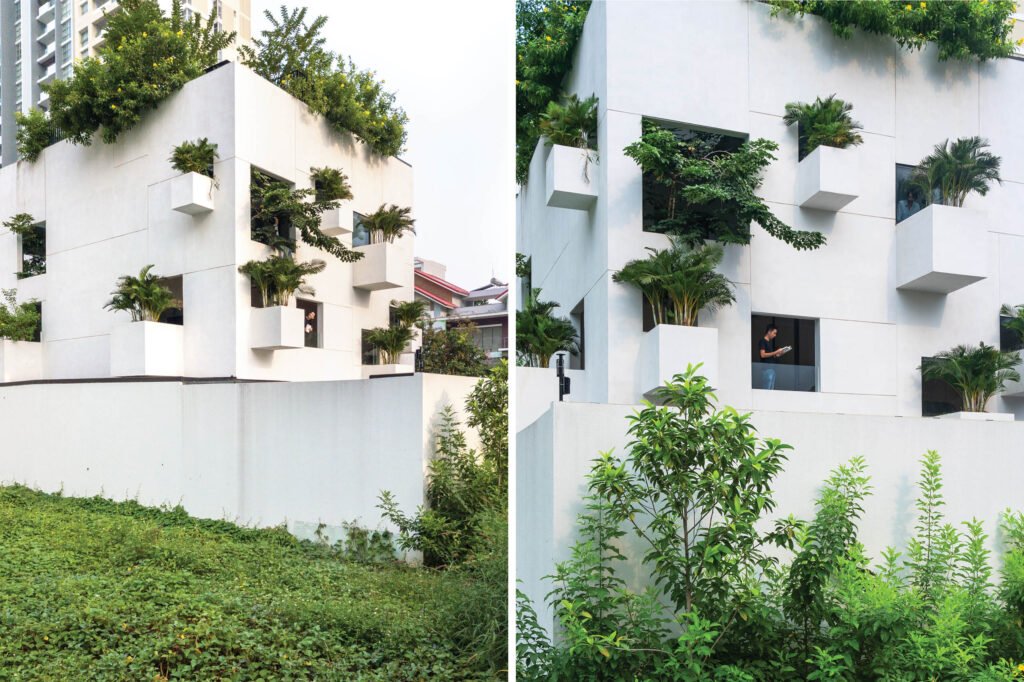

The interview began with Nguyen describing the context of the 20-by-12-meter site. He spoke of the high density of construction in Ho Chi Minh City, the traffic congestion and pollution, and said that on his visit to Manila some years back, he saw we had more parks and green spaces than they did. (Maybe he was billeted near Luneta Park.)
Then Favila asked about the client and the brief. “I was a bit apprehensive at first,” she recalls, “whether he really took the client’s needs and user-experience into account. As an interior designer, clients sometimes call me to revise spaces designed by architects. Often, there’s not enough storage, or they design windows without thinking of heat and privacy, and those were two things I could see might be a problem.”
“I am the client,” Nguyen replied. We all had a big laugh.
“Ah! Then what were your wife’s requirements?” I asked.
“My wife, she said I could do whatever I like!” And we all burst into laughter again.
“That’s very rare,” said Favila. “Usually, it’s the wife who gives all of the requirements.”
“Oh, I’m very lucky!”
“When was this completed?”
“One and a half years ago (2019). It took me four years. Three years for design.”
“Why?”
“Because I didn’t know what I want.” Then we all laughed again.
“Oh, I can relate!” Favila said, still laughing. “We are our worst clients.”
“Yeah, yeah. One day, I say, ‘Ah, this is a very good option. Good concept, very good design.’ And then tomorrow, I say, ‘Hmm, I have a better idea.’ And so, I keep drawing on and on for three years.”
“How did you know when the design was finally what you wanted?” I asked.
“I say to myself, ‘If I keep going this way, I’m sure I will never have the final concept.’ So, I said, ‘Stop!’”
We laughed yet again and several times more, with Nguyen sometimes making us guess where he hid things, like the refrigerator and oven range in the kitchen, or the shades for the bedrooms’ sliding glass doors and bathroom windows.
The ground floor
To promote the deep horizontal and vertical connection between human to human and human to nature in the house, Nguyen and his team created “connections between the spaces so that natural elements can be present and carried through every corner of the house.” MIA Design Studio explains further: “Without any external influence or intention to maximize areas for unnecessary rooms, the design process started by dividing the house in two parts. The first half is devoted to the sun, wind, water and trees with its empty spaces, while the other half is dedicated for family activities with necessary utilities.”
The entire 240-square-meter lot is enclosed by white concrete perimeter walls. They only way into the house is through the driveway. From the driveway, one enters a small “lobby” where one may go straight upstairs or turn right and take the door to the living-dining-kitchen area.



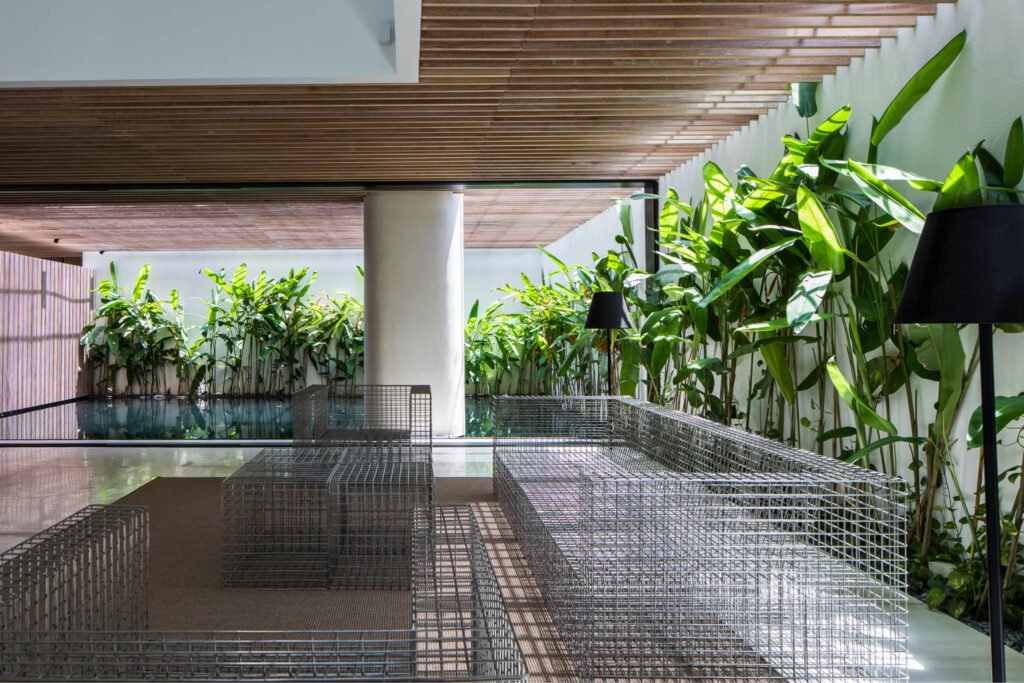
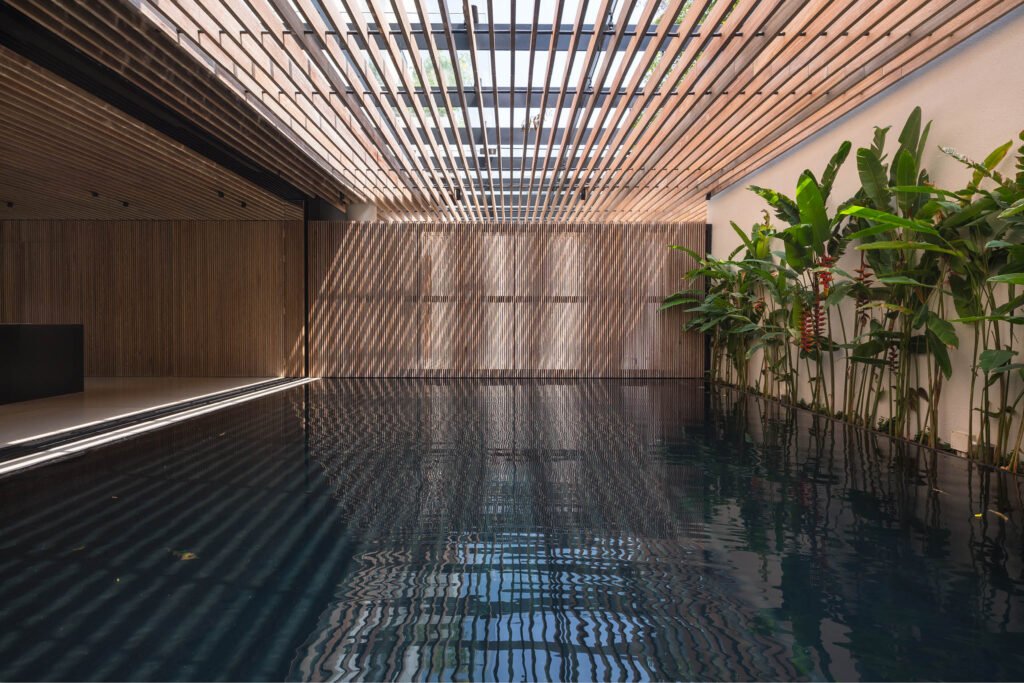

Unlike many houses in the Philippines whose living areas are built right up to the required setback, Nguyen kept their living space down to a footprint of 10 by 12 meters—exactly half of the lot. “Half for living and half for looking,” he said. He didn’t want to make more rooms than needed or make rooms larger than they needed to be.
Because of this, there is no extraneous furniture. The dining table is an extension of the kitchen countertop. The living room furniture, like the dining chairs, were picked for their transparency, so as not to disrupt the minimalism of the living space. “I don’t want to see many fancy things,” said Nguyen. The one exception is a baby grand piano, whose ebony blackness announces its weight and importance in the family’s life.
The living area is ringed on three sides by greenery and on one side by a 7.7-by-5.2-square-meter koi pond, affording the modest-sized living area with the luxury of breathing space and serenity. “You can swim in it, said Nguyen. A bio system treats the pool so “the quality of water is the same as a stream.”
The void
What makes the home a design triumph is the 4-by-4-square-meter void above the living area. The void reaches up to the sky, cutting through the second, third, and fourth-story floor plates. It connects all the floors of the house together and gives family members glimpses of each other in their rooms. The unexpected vertical shaft in the architecture realizes Nguyen’s notion of man and man’s and man and nature’s vertical relationships. Its existence contrasts the horizontality of the ground floor, the hearth of the home, surrounded by green and water.
The drama doesn’t stop there.
Nguyen didn’t want his children living amidst expensive possessions. He wanted his six and two-year-old growing up contemplating the sun, wind, water, and trees, not just in the spaces of the home the family shared, but in their private spaces as well. And so he gave each of them a terrace with a tree growing outside their little bedrooms on the second floor.

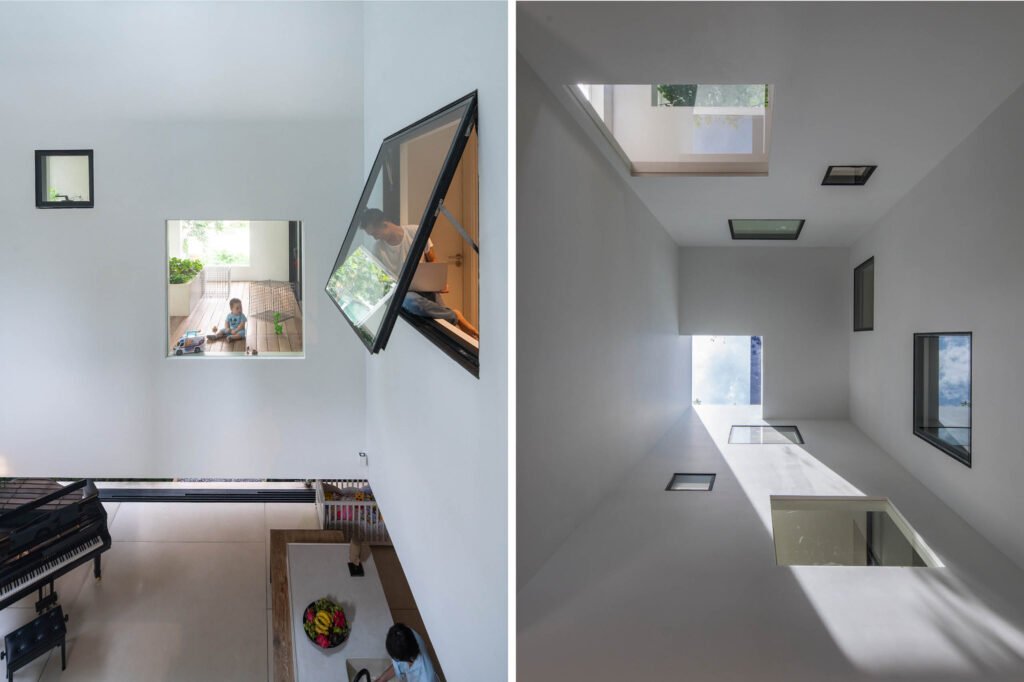
The second-floor terraces
Like the central void, the two trees reach for the sky, their branches spreading outside of the house through windows and their leafy tops adorning the parents’ bedroom on the third floor.
Looking at the photos, Favila and I were incredulous.
“The skylights are open?” she asked gently. “So when it rains, the water goes to the tree?”
“Yeah.” He laughed, anticipating our next question.
“Doesn’t the rain also fall directly on the floor?”
“Yeah, yeah. No problem. I’m still happy to live in that.”
“Okay, so the floor gets wet. What is it you use here? Wood or tiles?”
“This is outdoor wood, okay to get wet. And between the wood, I have small gaps. Underneath the wooden floor is a drainage system. So, I don’t have to worry about water entering the house.” Favila and I were relieved. We were imagining torrential rain flooding the second floor. I asked for a section drawing of the tree boxes and drainage system. He said no problem. “I have to always be careful that all the details have been taken to account. Everything!” he assured us. “I have made sure. When the people don’t see it, it can be a very big question for them, I know.”
He laughed, so we laughed.



Favila and I asked about ventilation, storage, and privacy, our pet peeves. He assured us we would get the floor plans and more photographs than are currently posted on his website.
“When you look at it, you don’t see it. Very simple. But when you need it, everything is there. Yeah. I have very big storage in the house, everywhere. I know perfectly well my lifestyle and what I’m going to use. For instance, I have only three pairs of clothes for myself, all in black, so I don’t worry about choosing what to wear. In the bathroom, everything hidden. Behind the mirror is a cabinet where I can find the things I need.”
Favila persisted: “I notice in the rooms you don’t have any form of window treatment. Shades or curtains. How do you address heat and privacy?”
“You don’t see it? I have! Everything is hidden, everything disappears when you don’t need it. Let’s look at the pictures inside looking out. If you look carefully, you see the gap between the ceiling and the doors. It’s very small. There we put the electric rollers for shading—immediately, in one minute, the room will be blacked out! See the window. Can you see the gap? It is only a very thin guideline.
“All these require more work to see less. And very close work with the structural engineer and MEP. I designed this house for three years. Every single little detail, I managed on the design, not onsite. Only after every detail works, then we start to build.”
“Brilliant!”
“Perfect. Brilliant!” We broke into applause.
“Thank you. Thank you so much.”
After the Zoom interview, after Nguyen left the “room,” Favila and I did a debrief.
“We had a good laugh when Manh revealed he was the client, didn’t we? What did you think of Manh, Vianca?”
“I thoroughly enjoyed talking to him! He is such a humble and passionate architect and its always a pleasure discussing design with like-minded individuals. He simply had the right answers to all my questions on storage, maintenance, lighting, even how the plants are watered. And taking three years to design his home? It was such an honest and real answer which I totally can relate to.”
“What about his wife letting him decide everything?”
“Hmmmm. I think when you are married to an architect or interior designer, there is a level of trust that your spouse will design what’s best for the family, whether the designer is the husband or the wife! Or so I’d like to believe. I should probably ask my husband why he left it all up to me too.”
We agreed to meet again on Zoom after Nguyen’s office sent us the plans and additional photos. Here are excerpts of our Zoom, email, and Google Drive exchanges.


The critique
It was clear to me Manh wanted a tropical house connected to nature but didn’t want to have to look at his neighbors, so he designed an inward-looking house with indoor greenery. And from the inside looking out, the plant boxes give the impression of having gardens right outside. What’s your reaction to Manh’s strategy?
I think it wasn’t so much about not wanting to look at his neighbors but more that the house is located within a city where greenery is scarce. Having a home surrounded with elements that remind you of an oasis outside the city is ingenious and so relevant, especially now (the COVID-19 pandemic) that we are mostly in our homes and can’t really travel to the beach or go to parks often.
Surrounding the living area and bedrooms with natural elements of earth, wind, water, and access to sunlight are a wonderful way of bringing the outdoors in.
It’s interesting that MIA Design Studio used a vertical approach as an alternative to opening the four sides of the house, creating this beautiful connection between the sky and the house. The question, though, really wasn’t about aesthetics. Going back to user experience and maintenance, I really wanted to understand their irrigation system, sustainability, and even insulation. Like we said in the interview, with all those glassed windows and skylights, the place must be so hot. And so I wondered how sustainable the house could really be if the family had to use air conditioning often.




Wow, the living-dining-kitchen area is really modest in size, Vianca. Only 10 by 12, including the hidden appliances, storage, powder room, and laundry area. I’m amazed how big the space looks in pics. Without the hidden areas, the living-dining-kitchen is only 10 by 8.
With the play of open spaces, nature, and the lightwell, the space looks and probably feels more spacious than its actual dimensions, which is one of things I love about this home—you truly know it was well planned and thought through. Designers use little tricks to create an illusion of space. Here it is achieved by the random pops of windows, the white paint, as well as the horizontal lines of the long span slats that stretch across the ceiling.
What about kitchen smells in the small living area? It should be still okay, no? Because there’s so much open space on the ground floor and the hot air will go straight up.
There is an exhaust in the ceiling hidden by slatted panels that look like the wall claddings but are actually hidden storage, which is my favorite part of this home. Apart from the exhaust, considering all the open spaces, I don’t think this would be a problem.
I like how they showed how the space is being used and they actually photographed Manh’s kid and baby in their rooms and playing with toys. Honestly, though safety is a real concern for me. Looking at the photos with the guy at the window just above the kitchen? Although large window openings are key to proper cross-ventilation, I worry that someone may accidentally fall there.
Kids can be taught to be careful in their living environment—but they have to be taught! It’s more likely a visiting kid might fall.
What do you think of the dining area? I never would have thought of a “proper” dining table connected to the kitchen counter. Although it must be convenient for the mom to serve food straight from the range to the countertop. Then after dinner, the dishwasher is right there, by the sink.
We actually often do this type of layout for small spaces like condo units. But I do find it quite interesting how we see a generous amount of space in this home but Manh still implemented such a space-saving design. As he explains it, he meant to divide the house into two areas. One just for “looking at” as Manh calls it, and the other where all the family activities happen. If you look at the floor plan, you’ll see the equal proportion of the water feature and planting area to the “activity space,” which is further subdivided into cooking, dining, lounging, and entertainment (piano).
There really is no hard and fast rule—it is always dependent on the user of the space and how they manage to do their day-to-day activities in it. I assume the convenience of a linear, combined kitchen and dining area is something Manh’s family appreciates, and it really goes well with the minimalist aesthetic of the house.


The aesthetic is luxurious, but the dimensions and simplicity of the living spaces reflect a modest lifestyle. That’s something.
The beauty of minimalism lies in attention to detail, and I would consider Manh’s house more premium than most. It takes a lot to pull off a minimalist design. The materials he used are all natural, like the wood slats on the ceiling and walls of the kitchen-dining area are solid wood, not just laminated sheets. The flooring is all-natural stone, not just tiles. The furniture pieces are bespoke and the hidden storage, hidden window treatments, and the irrigation system for the plant boxes and the pool are all complicated systems, which are details unseen but are “premium” details, nonetheless. Even the choice of plants, for me, shows luxury in this beautiful home.
You’re right. Just the plumbing, waterproofing, and structural support for indoor and outdoor roof plant boxes must have cost quite a bit!
At first glance, you’d wonder how functional the space really is. I find it interesting that this home is built for a family with young kids. Being a mom myself, keeping a house neat and organized with young kids is close to impossible and him showing this photo of how the space is indeed being used (with some toys and a toy car scattered about) makes the space feel more “human” to me apart from it being aesthetically pleasing.
As one may learn in design, there is always more than meets the eye, and it was fun to learn about all the tricks this house had to offer
Each kid’s bedroom has its own terrace, which faces the central void. What a fantastic arrangement! The position of the staircase is unusual but being able to go upstairs without being seen from the living area has its benefits. The two kids share a bathroom, though. I would have separated the bath from the toilet, so one kid can use one space while the sibling uses the other.
I agree. When the kids get older, having to share a T&B is quite daunting.




The third floor
My gosh, I love the master bedroom. It reminds me of childhood fantasies of sleeping in a treehouse.
Yes, the function of a master bedroom is really for rest and it truly is shown in this design—no TV, no knick-knacks, or décor. Simple, clean, and functional with nature as your sculpture and the play of light and shadow as your wall art.
The cut in the floorplate is where I’m terrified someone might fall.
I don’t think there’s a barrier but I believe the water around the tree can serve as a “mental barrier” in a way.
Of course, they can child-proof the sliding doors. But this now makes me wonder about cross ventilation. They can’t cross ventilate unless the sliding doors and the window to the void are open.
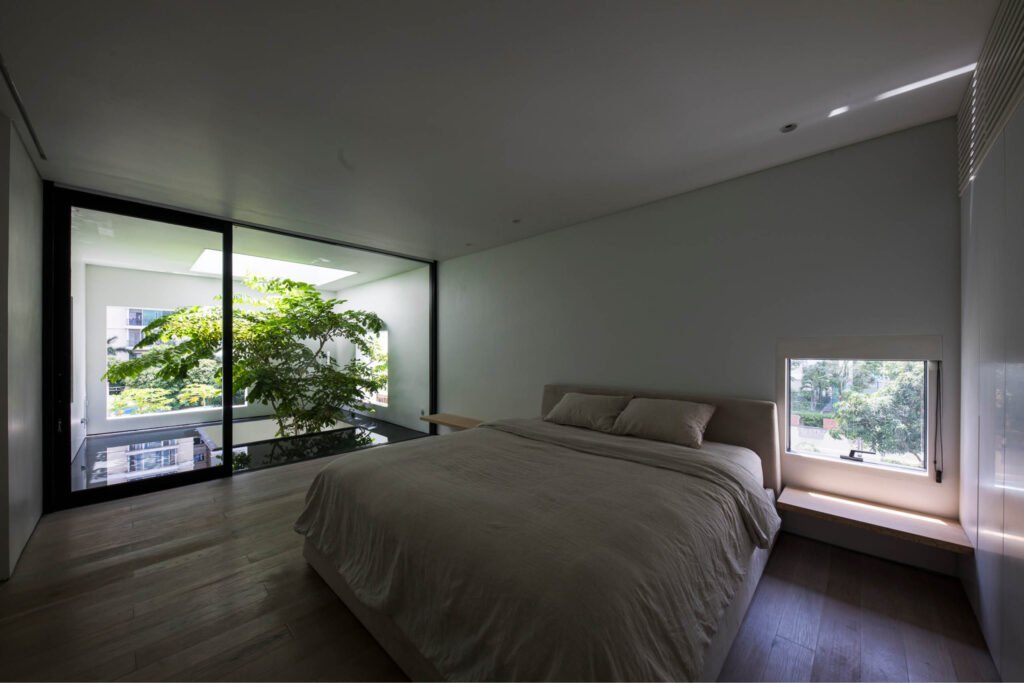

I want to voice my concern over storage again. Not sure if it’s a Filipino thing, but we love to hoard supplies “for a rainy day,” so storage for extra towels, shampoo, and the like for me is a non-negotiable.
You’re so right! But this really could be Mr. and Mrs. Nguyen’s lifestyle, you know.
If there were a way to close the atrium with a special automated mechanism, having trees inside the house like this might work here in the Philippines. But without some protection during our category 4 and 5 typhoons, they might even pose a danger as wind-whipped branches hit the glass of the rooms.




The Sky House altar
MIA Design Studio describes the fourth-floor altar and roof garden this way:
“A garden surrounds a covered ‘altar’ space on the fourth floor, providing a quiet meditation space where the family can relax and retreat from the busy urban life below. The roof garden is planted with vegetables and herbs for use in the family’s meals, for the kids to learn about agriculture and increase their interaction with nature in the urban environment. The structure of the altar is a pre-engineered steel structure with a 10-millimeter-thin steel roof like a pair of outstretched wings, supported by multiple 20-millimeter-diameter rebar, which act as a vine rig for climbing vegetables. The floor is covered with gravel to enhance the outdoor atmosphere.”
I’m so happy there’s a roof garden. It surely cools down the master bedroom suite below.
I love this. Being a green thumb myself, I always dream of a home that can sustain itself—growing my own food and making sure everything remains organic. I love how they created this especially for their kids, where most parents focus learning on academics, they created experiential learning activities for their kids right on their rooftop.




I would rate the Sky House 4.5 stars out of 5. Of course, I have to take Manh’s word that he thought of everything and that his wife is fine with the layout as it is but I have an issue with the shared bathroom for the kids. He could have made things a little easier for them. I’m also not satisfied with the powder room and laundry area tucked away behind the kitchen wall. If I were Mrs. Nguyen, I would locate the laundry and drying area up on the roof deck, since they have two water tanks up there. The greenery would easily hide the laundry area from the Sky House altar and memorial garden. How about you, Vianca?
The design of the space works so well which is in part because the designer is the client. Knowing what matters to him and his family allowed him and his team to focus on the essentials for the living spaces—nothing more nothing less, with just enough space to go about their lives successfully and clutter-free.
Devoting 50 percent of the home to nature shows how important it is for the parents and, hopefully, for the children too, when they grow up. The design is well-planned and the flow of the divided spaces inside the home is like a yin and yang, which together create a peaceful sanctuary for the family. The design is a breakthrough from the norms of city living and a reinvention of bringing the outdoors in.
I would give this home a 4.5-star rating. Although I love the house so much, I still cannot give it 5 stars because of the safety concerns with the operable windows in the central void and the areas surrounding the two trees on the third floor. Putting my mom-hat on, I would maybe add glass railings to maintain clear sightlines to the trees and maybe a screen or stylized grill as protection for the windows in the void—not so aesthetically pleasing, I know, but certainly, something to be reconsidered, if they haven’t already. I too would have preferred an en suite T&B for the kids’ rooms in anticipation of busier mornings when they grow older. •


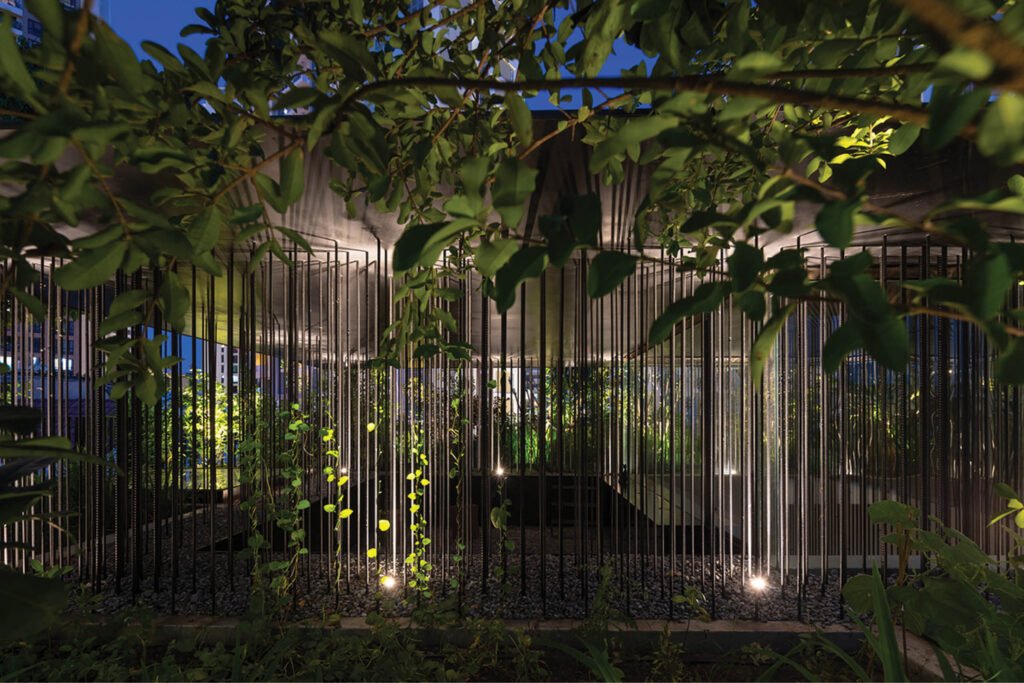

Judith Arellano Torres is the former editor-in-chief of BluPrint magazine, which she led for ten years. She edited four books, Blueprints for 2050, Design Better, Tropical Architecture for the 21st Century Books 1 & 3, and co-wrote the latter two. Before BluPrint, Judith worked for 17 years in television in a variety of roles, including COO of the ABS-CBN News Channel (ANC); COO, executive producer, and editor at Probe Productions, Inc.; and producer for CNN International, covering the Philippines, Indonesia, Malaysia, and Singapore.
Interior designer Vianca Añonuevo Favila is one of the creative minds behind the international award-winning interior design firm, Empire Designs, whose clientele includes luxe hospitality and residential developers, successful and aspiring individuals, and growing families. Favila is also the managing partner and co-founder of the custom furniture shop, Harver Hill, and Gussy Design, the first e-design platform for home furnishings in the Philippines. One of her passions is teaching young designers, which she does as a faculty member of the Philippine School of Interior Design.
Kanto.com.ph is a proud co-presenter of Anthology Festival 2021. This interview was produced in support of the Festival and its organizers, WTA Architecture and Design.




5 Responses
Congratulations, Nguyen Hoang Manh and MIA Design Studio for being shortlisted at the World Architecture Festival 2021!